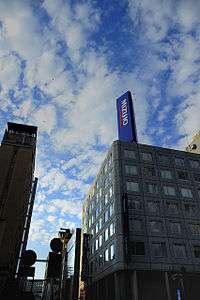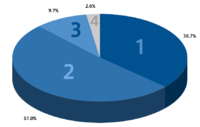Mizuho Financial Group
 | |
|
Mizuho Financial Group Headquarters the Otemachi Tower in Tokyo since 2014 | |
| Public | |
| Traded as |
TYO: 8411 OSE: 8411 NYSE: MFG |
| Industry | Banking, Financial Services |
| Predecessors |
Dai-Ichi Kangyo Bank Fuji Bank Industrial Bank of Japan |
| Founded | 2001 (from merger) |
| Headquarters | Marunouchi, Chiyoda, Tokyo, Japan |
Key people |
Yasuhiro Sato (President & CEO) |
| Products | Credit cards, consumer banking, corporate banking, investment banking, global wealth management, financial analysis, private equity |
| Revenue | ¥2.111 trillion (2012) |
| ¥662.83 billion (2012) | |
| ¥656.38 billion (2012) | |
| Total assets | ¥166.36 trillion (2012) |
| Total equity | ¥4.470 trillion (2012) |
Number of employees | 56,109 (2012) |
| Subsidiaries |
Mizuho Bank Mizuho Corporate Bank Mizuho Trust & Banking |
| Slogan |
Channel to Discovery ONE Mizuho |
| Website | www.mizuho-fg.co.jp |


1. Mizuho Bank
2. Mizuho Corporate Bank
3. Mizuho Trust
4. Mizuho Securities
Mizuho Financial Group, Inc. (株式会社みずほフィナンシャルグループ Kabushiki-gaisha Mizuho Finansharu Gurūpu), abbreviated as MHFG, or simply called Mizuho, is a banking holding company headquartered in the Ōtemachi district of Chiyoda, Tokyo, Japan. The name "mizuho (瑞穂)" literally means "abundant rice" in Japanese and "harvest" in the figurative sense.
It holds assets in excess of $2 trillion US dollars through its control of Mizuho Bank, Mizuho Corporate Bank, and other operating subsidiaries.[1] The company's combined holdings form the second largest financial services group in Japan. Its banking businesses rank the third in Japan after MUFG and SMFG, and the ninth in the world by market capitalisation as of November 2009.[2] It is the 59th largest company in the world according to Forbes Global 2000 rankings. Its shares have a primary listing on the Tokyo Stock Exchange.
Mizuho offers a range of financial services, including banking, securities, trust and asset management services, employing more than 68,000 people in 30 countries. It also functions as one of the main companies of the keiretsu Mizuho Group, formed from the former DKB Group and the former Fuyo Group.
Divisions and brands
Mizuho splits its business into four distinct divisions, on a global basis:
Retail Group
Mizuho is active in retail banking with 515 branches and over 11,000 automated teller machines (ATMs). Mizuho Bank is the only bank, other than Japan Post Bank, to have branches in every prefecture in Japan. It serves over 26 million Japanese households, 90,000 SME customers, and retail brokerage clients under the name Mizuho Investors Securities nationwide.
- Mizuho Bank
- Mizuho Investors Securities
- Mizuho Capital
Global Corporate Group
Mizuho predecessors, the Dai-Ichi Kangyo Bank (“DKB”), the Fuji Bank (“Fuji”) and the Industrial Bank of Japan (“IBJ”), had great control over many Japanese companies through keiretsu system. The three banks led the DKB Group, Fuyo Group and the IBJ Group respectively. The Fuyo Group traces its history as far back as the old Yasuda zaibatsu. Even now, seven out of ten companies listed on the Tokyo Stock Exchange have dealings with Mizuho.[3]
Global Wealth and asset management
- Mizuho Trust
- Mizuho Private Wealth Management
- Mizuho Asset Management
- DIAM
Strategy affiliates
- Mizuho Financial Strategy, formerly Mizuho Holdings, Inc.
- Mizuho Research Institute
- Mizuho Information & Research Institute
Offices
-
.jpg)
Former Mizuho Financial Group headquarters (now Otemachi Tower), formerly Fuji Bank head office, in Ōtemachi, Tokyo until 2014.
-
.jpg)
Mizuho Bank head office in Uchisaiwaicho, Tokyo (see also Mizuho Bank Head Office Building)
-

Mizuho Corporate Bank head office, formerly the Industrial Bank of Japan head office, bordering MHFG HQ in Ōtemachi, Tokyo
-

Mizuho Securities Co. occupies Ōtemachi First Square, bordering MHFG HQ, in Ōtemachi, Tokyo
Sponsorship
History
Mizuho was established originally as Mizuho Holdings, Inc. by the merger of Dai-Ichi Kangyo Bank, Fuji Bank, and the Industrial Bank of Japan in 2000.
Mizuho Financial Group, Inc. was established in January 2003 to become the parent company to Mizuho Holdings, Inc. in preparation for its restructuring of businesses. Subsequently, through a share exchange on March 12, 2003, Mizuho Financial Group became the sole shareholder of Mizuho Holdings, which in turn served as the holding company of all of the group's banking and securities units.
On October 1, 2005, all subsidiaries of Mizuho Holdings were transferred to the direct control of Mizuho Financial Group. Mizuho Holdings, no longer a bank holding company, was then renamed Mizuho Financial Strategy, which now focuses on providing advisory services.
Mizuho, through its operations in New York became involved in the subprime mortgage crisis and lost 7 billion dollars on the sale of collateralized debt obligations backed by subprime mortgages. Its entry was late, in December 2006; it did not participate in gains; only suffered losses. It is the Asian bank which suffered the most losses due to the crisis. The venture into this field has been traced to the employment of Alexander Rekeda, a specialist in this field hired away from Calyon, a unit of Crédit Agricole. Rekeda was made "head of structured credit in the Americas" where he floated several deals that turned toxic. He was later fired and Mizuho shut down its US CDO business. Examples of these CDOs included the "Aardvark", "Tigris", and "Delphinius" CDOs.[4] The latter two involved the Magnetar hedge fund.[5] Ironically, Calyon had sued Mizuho for hiring away Rekeda and other CDO experts in 2007.[6]
Timeline
- 1864: Yasuda-ya is founded as a private company.
- 1883: The Dai-Ichi Bank, Ltd. is established as the first bank in Japan.
- 1897: The Nippon Kangyo Bank, Ltd. and the Industrial Bank of Japan, Limited are established as a governmental institution.
- 1912: Yasuda-ya is incorporated and renamed Yasuda Bank.
- 1948: Yasuda Bank is renamed the Fuji Bank, Limited.
- 1950: The Nippon Kangyo Bank and IBJ are privatized.
- 1971: The Dai-ichi Bank and the Nippon Kangyo Bank merge to form the Dai-Ichi Kangyo Bank, Limited.
- 1999: DKB, Fuji and IBJ announce an agreement to consolidate the three banks' operations.
- 2000: DKB, Fuji and IBJ establish a holding company named Mizuho Holdings, Inc.
- 2002: DKB, Fuji and IBJ are officially and legally combined into two banks, Mizuho Bank, Ltd. and Mizuho Corporate Bank, Ltd.
- 2003: Mizuho Financial Group, Inc. takes over the operations of Mizuho Holdings virtually.
- 2006: Mizuho is listed on the New York Stock Exchange under the stock symbol MFG.
- 2009: Mizuho established an alliance with and invested in Evercore Partners Inc.[7]
Notable employees
- Yoichiro Esaki, member of the House of Representatives
- Rin Ishigaki, poet
- Hirotaka Ishihara, member of the House of Representatives, son of Shintaro Ishihara
- Zenkichi Kojima, mayor of Shizuoka, Shizuoka
- Takeaki Matsumoto, member of the House of Representatives
- Shoichi Nakagawa, Minister of Finance, Minister of State in charge of Financial Services (2008–2009)
- Kei Ogura, singer
- Stanley Praimnath, survivor of the destruction of the World Trade Center on September 11th, 2001
- Alexander Rekeda, structured several deals involving collateralized debt obligations backed by subprime mortgages.[4]
- Mitsu Shimojo, member of the House of Representatives
- Yukio Tomioka, member of the House of Councillors
See also
Competitors
References
- ↑ http://www.mizuho-fg.co.jp/english/investors/financial/fin_statements/data11/pdf/fy.pdf
- ↑ "The Top 1000 World Banks 2006", The Banker, 3 July 2006.
- ↑ IR Presentation at “CLSA Japan Forum 2005” 7 March 2005
- 1 2 Flynn, Finbarr (2008-10-29). "Mizuho $7 Billion Loss Turned on Toxic Aardvark Made in America". Bloomberg. Retrieved 2008-10-29.
- ↑ Timeline of Magnetar Deals by Jake Bernstein, Jesse Eisinger and Krista Kjellman Schmidt, ProPublica, April 9, 2010
- ↑ Calyon Cries Foul: French bank seeks retribution after CDO team defects to Mizuho, Investment Dealers' Digest, March 26, 2007, Pyburn, Allison
- ↑ "MIZUHO FINANCIAL GROUP INC (8411:JP): Company Description - BusinessWeek". investing.businessweek.com. Retrieved 25 January 2011.
External links
| Wikimedia Commons has media related to Mizuho Financial Group. |
- Mizuho Financial Group
- Mizuho Financial Group Inc. by Google Finance
- Mizuho Watch by Inner City Press
| ||||||||||||||||||||||||||
| ||||||
|